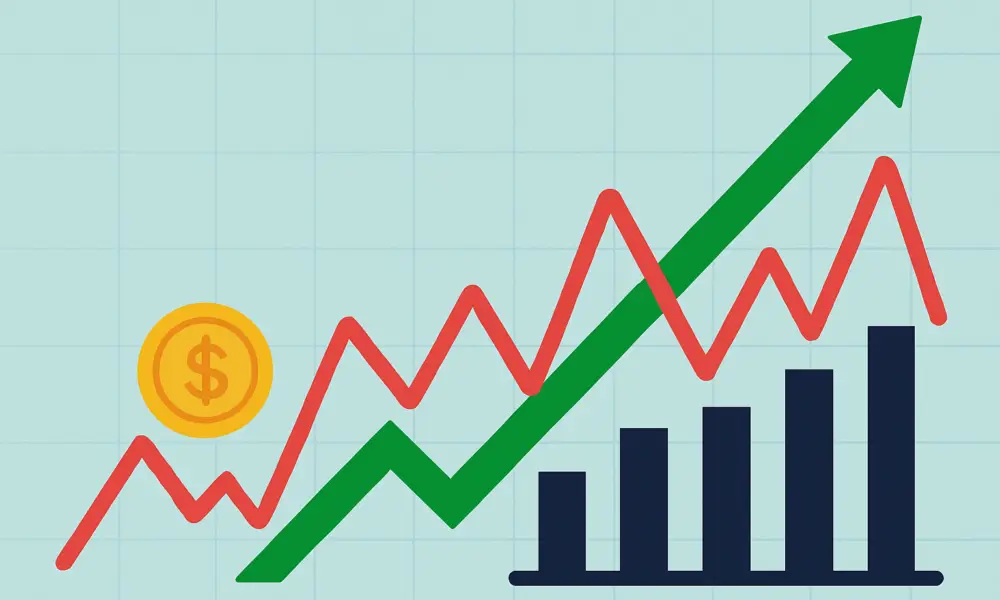Navigating Turbulent Waters: How to Act in Volatile Markets and Protect Your Assets
Have you ever felt that knot in your stomach when watching your assets fluctuate dramatically in just a few days? That cold sweat when following economic news that seems to predict a financial apocalypse? You’re not alone. Instability in financial markets is something that keeps both novice and experienced investors awake at night.
How to act in volatile markets is an essential skill for anyone looking to build and preserve wealth over the long term. Turbulent moments occur regularly in the global economy, and many investors end up making hasty decisions based on fear or momentary euphoria, which can compromise years of financial planning.
In this article, we’ll explore in depth the best strategies to navigate safely during periods of strong market fluctuations. More than just surviving, you’ll learn how to transform crisis moments into opportunities to strengthen your investment portfolio.
Understanding Volatility: Why Do Markets Fluctuate?
Before we talk about how to react, it’s essential to understand what causes volatility in markets. Fluctuations aren’t necessarily negative – they’re a natural part of the economic cycle and can occur due to various factors:
- Geopolitical events: wars, international agreements, elections
- Monetary policy decisions: changes in interest rates by central banks
- Economic indicators: GDP, inflation, unemployment
- Corporate results: quarterly company earnings
- Technological innovations: disruptions in traditional sectors
- Mass investor behavior: collective panic or euphoria
Volatility, by itself, is not a problem. However, the real challenge lies in how we emotionally react to it. Our human brain developed to respond quickly to threats, which explains why we tend to make hasty decisions when facing investment instability.
The Dangers of Emotional Decisions in the Investment World
When markets fluctuate sharply, our emotions kick in. Fear and greed – two powerful feelings – frequently lead us to act against our own long-term financial interests.
Neuroscience studies show that, under stress, the rational part of the brain (prefrontal cortex) gives way to more primitive and emotional responses, driven by the amygdala. This phenomenon explains why many investors buy at the peak of euphoria and sell at the bottom of panic – exactly the opposite of what would be ideal.
Maria, a 42-year-old investor I follow, shares that during the 2020 crisis, she sold all her stocks when the market had fallen almost 30%. “I couldn’t sleep thinking I would lose everything. I sold out of fear, but the market recovered in the following months, and I missed the chance to recover my losses,” she laments.
This experience perfectly illustrates how unmanaged emotions can severely damage wealth built over years.
8 Practical Strategies for Facing Volatile Markets
Now that we better understand the challenges, let’s look at concrete solutions – strategies that can be implemented to protect your assets and possibly even take advantage of turbulent moments.
1. Review and Strengthen Your Investment Plan
The first and most important strategy for acting in volatile markets is to have a well-defined plan and stay faithful to it. A solid plan should include:
- Clear objectives: short, medium, and long term
- Investment horizon: when you’ll need the resources
- Risk profile: conservative, moderate, or aggressive
- Asset allocation: how to distribute your investments among fixed income, variable income, and alternatives
- Rebalancing criteria: when and how to adjust your portfolio
“An investment plan is like a map in a storm. Without it, you’re adrift,” explains Paulo Guedes, an investment advisor with over 20 years of experience. “During volatile moments, revisiting your original plan helps avoid impulsive decisions.”
It’s not the time to completely rewrite your strategy amid turbulence, but rather to review it to ensure it’s still aligned with your long-term goals.
2. Properly Diversify Your Investments
Diversification remains one of the most effective strategies for protecting assets. But it’s not just about having several assets – you need to ensure they react differently to the same market events.
Efficient diversification can include:
- Diversification across asset classes: fixed income, stocks, real estate funds, international assets
- Sector diversification: investing in different sectors of the economy
- Geographic diversification: distributing investments across different regions and countries
- Temporal diversification: making contributions at different times (avoiding betting everything at once)
“Many investors think they’re diversified because they have 20 different stocks, but if they’re all from the same sector or have similar characteristics, the protection will be limited,” warns Regina Sarmento, an allocation strategist at a major Brazilian asset manager.
In turbulent periods, a truly diversified portfolio tends to suffer less because while some assets fall, others may remain stable or even appreciate.
3. Maintain an Opportunity Reserve
Beyond the traditional emergency reserve, which should cover 6 to 12 months of expenses, it’s intelligent to maintain an “opportunity reserve” – resources that can be quickly allocated when good buying opportunities arise.
During significant market drops, solid companies are often available at discounted prices. Having liquidity in these moments allows you to take advantage of these opportunities without compromising your financial flow.
“In March 2020, those who had available resources managed to buy excellent companies for half the price of January of the same year,” exemplifies Rodrigo Torres, a wealth manager. “It’s not about hitting the exact bottom of the market, but about having ammunition when quality assets become cheap.”
This reserve can be kept in highly liquid, low-risk applications, such as Treasury bills, certificates of deposit with daily liquidity, or money market funds.
4. Adjust Your Contribution Pace with Dollar-Cost Averaging
In moments of strong volatility, the strategy of dollar-cost averaging shows its value. Instead of making large contributions all at once, divide them into regular installments over time.
This approach brings two main benefits:
- Reduced timing risk: you don’t need to guess the “best time” to invest
- Leverage average prices: buy more shares when prices are low and fewer when they’re high
“The average investor can’t predict short-term market movements. By making regular contributions, you take that pressure off your shoulders,” recommends Carla Mendes, a financial educator. “It’s a mathematical way to reduce the emotional impact of volatility.”
This strategy is especially useful for those who invest monthly from their salary or regular income.
5. Take Care of Your Mental and Emotional Health
Not everything boils down to investment techniques. Taking care of mental health is fundamental to making better financial decisions, especially in turbulent periods.
Some recommended practices:
- Limit consumption of financial news: being informed is different from being obsessed
- Set specific times to look at your portfolio: avoid compulsive checking
- Practice stress reduction techniques: meditation, physical exercise, hobbies
- Talk with trusted people: having someone to discuss your concerns helps organize thoughts
“The investor’s greatest enemy is themselves and their unprocessed emotions,” states Ricardo Costa, a psychologist specializing in behavioral finance. “During crises, people frequently seek validation for their worst decisions, instead of seeking emotional balance.”
Remember that important financial decisions should not be made in moments of high emotional tension.
6. Review the Quality of Assets in Your Portfolio
Volatile markets are excellent for testing the resilience of your investments. It’s the moment to carefully evaluate the quality of each asset in your portfolio:
For stocks and real estate funds:
- Does the company have sustainable competitive advantages?
- Does it have a healthy balance sheet with low debt?
- Is the business model resilient to crises?
- Does management have a history of prudent decisions?
For fixed income:
- How solid is the issuing institution?
- Do the contracted rates compensate for the risk?
- Is the duration aligned with your investment horizon?
“Crises separate solid companies from fragile ones. Use this moment to filter which businesses really deserve your money in the long run,” suggests Henrique Bredda, a fund manager specializing in fundamental analysis.
Don’t hesitate to get rid of assets that don’t pass this careful review, even if it means realizing some loss.
7. Consider Specific Protections for Your Portfolio
More sophisticated investors can use specific protection strategies during periods of high volatility:
- Hedge with options: using puts to protect stock positions
- Temporary increase in allocation to low-volatility assets
- Exposure to assets that tend to appreciate in crises (such as gold or the dollar)
- Long-short strategies: taking advantage of both market rises and falls
“Protections have a cost, which many investors are reluctant to pay in calm times. But when the storm arrives, those who protected themselves earlier can sleep better,” explains Maurício Bittencourt, a derivatives specialist.
It’s important to emphasize that these strategies require advanced technical knowledge or professional monitoring and are not recommended for all investor profiles.
8. Take the Opportunity to Reassess Your Real Risk Tolerance
Many investors discover their true risk tolerance only during crises. Use this moment for an honest self-analysis:
- How did you feel when you saw your investments fluctuating?
- Did the drops affect your sleep or quality of life?
- Were you able to maintain discipline, or did you feel the impulse to sell everything?
“It’s easy to consider yourself an aggressive investor during bull markets. The real test happens when your assets fall 30% in a month,” ponders Fernando Góes, a financial consultant. “Adjust your risk profile based on how you actually reacted, not on how you wish you had reacted.”
This honest reassessment can lead to adjustments in your future allocation, creating a portfolio more aligned with your emotional and behavioral profile.
Thinking Beyond the Crisis: Long-Term Strategies
Having navigated the most turbulent moments, it’s time to look at the broader horizon. How can you strengthen your position to face future volatilities with more tranquility?
Continuous Financial Education
Constantly investing in knowledge is as important as investing in financial assets. The more you understand about markets, economics, and investment behavior, the better prepared you’ll be to correctly interpret market movements.
“Financial education is like a life jacket in turbulent waters. It doesn’t stop the waves, but it keeps you breathing,” compares Ana Leoni, author of books on personal finance.
Seek diversified knowledge, not just about analysis techniques, but also about economic history, investor psychology, and risk management.
Automate Good Decisions
Establish systems that favor your financial discipline, reducing the need to make frequent decisions:
- Automatic monthly contributions
- Clear rules for portfolio rebalancing
- Predefined criteria for buying and selling assets
“The best plan is one you can follow systematically, even when emotions are running high,” recommends Carlos Massaru, a certified financial planner.
Establish a Support Network
Having trustworthy people to discuss investments can make a big difference in critical moments:
- Professional advisors: financial consultants and advisors
- Study groups: communities of investors with similar objectives
- Mentors: more experienced people who can share valuable perspectives
“Deciding alone in moments of extreme stress rarely leads to the best results. A qualified second opinion can prevent irreparable mistakes,” argues Daniela Falcão, an investor mentor.
When Inaction is the Best Action
One of the most counterintuitive lessons about how to act in volatile markets is that, frequently, not acting is the best strategy. If you’ve done your homework beforehand – assembling a diversified portfolio aligned with your objectives – often the best decision during moments of panic is simply… to do nothing.
“The market is a device for transferring money from the impatient to the patient,” Warren Buffett, one of the greatest investors of all time, once said.
When everyone is selling in panic, when alarmist headlines dominate the news, when it seems that “this time it’s different” – these are exactly the moments when discipline and calm pay the biggest dividends.
Learning from Past Crises
Analyzing the great financial crises of the last 100 years – 1929, 1987, 2000, 2008, 2020 – some lessons are recurrent:
- All crises eventually pass
- Markets tend to recover and exceed previous highs
- Moments of greatest pessimism usually precede recoveries
- Disciplined investors who maintained their positions or bought during drops were amply rewarded in the long term
“History doesn’t repeat itself, but it often rhymes,” Mark Twain is said to have remarked. Studying how markets behaved in previous crises doesn’t guarantee accurate predictions, but it offers perspective and comfort during challenging moments.
Conclusion: Transforming Volatility into Advantage
Volatility in financial markets is inevitable – as certain as the sunrise. What determines your success as an investor is not the absence of turbulence, but how you navigate through it.
The strategies we’ve discussed – from staying faithful to a well-structured plan to taking care of your emotional health – form a set of essential tools for transforming moments of instability into opportunities to strengthen your assets.
Always remember: the successful investor is not one who never faces drops, but one who develops the resilience to cross through them with intelligence and emotional balance. The history of financial markets repeatedly shows that those who manage to keep calm during storms are often those who go the furthest.
How have you been reacting to periods of volatility? Which strategies have worked best for your profile? Building this self-awareness is perhaps the most valuable investment you can make for your financial future.
Key Points
- Understand volatility as a natural part of economic cycles, not as something necessarily negative
- Review your plan regularly, but avoid drastic changes during crises
- Diversify properly across different asset classes, sectors, and regions
- Maintain a reserve of opportunity to take advantage of discounts on quality assets
- Use the strategy of dollar-cost averaging to reduce the impact of market timing
- Take care of your mental and emotional health to make more rational decisions
- Carefully analyze the quality of assets in your portfolio
- Consider protection strategies appropriate to your profile
- Honestly reassess your real risk tolerance
- Remember that, frequently, not acting is the best action during market panics



